AM906001 Corporate Governance and Leadership: A NZ Case Study
VerifiedAdded on 2023/04/07
|31
|5971
|172
Case Study
AI Summary
This case study analyzes the corporate governance structures of three New Zealand companies: Fonterra Cooperative Group, Sky Network Television, and Ngai Tahu Holdings Ltd. It examines their ownership structures, including farmer ownership in Fonterra, institutional investors in Sky Network Television, and community ownership in Ngai Tahu. The study explores different corporate governance models, such as the Anglo-US model (applied to Sky Network Television), the German two-tier model (applied to Fonterra), and the Japanese model (applied to Ngai Tahu), detailing their characteristics and how they are implemented within each company. The analysis extends to the legal responsibilities of the board, including fairness, transparency, accountability, and ethical behavior, as well as the social responsibilities of the corporations, including compliance with the Treaty of Waitangi. The study concludes with recommendations for improving corporate governance practices.
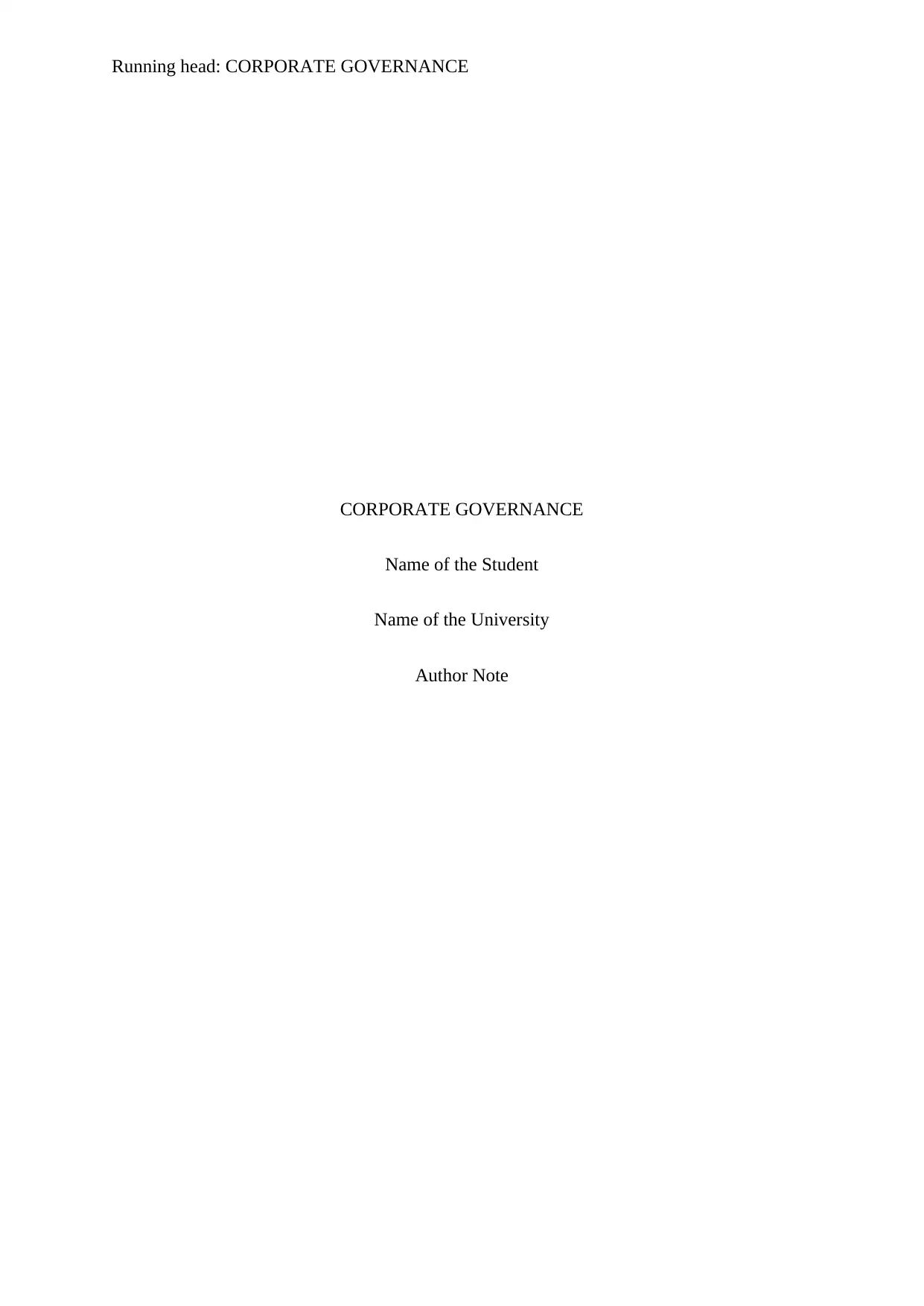
Running head: CORPORATE GOVERNANCE
CORPORATE GOVERNANCE
Name of the Student
Name of the University
Author Note
CORPORATE GOVERNANCE
Name of the Student
Name of the University
Author Note
Paraphrase This Document
Need a fresh take? Get an instant paraphrase of this document with our AI Paraphraser
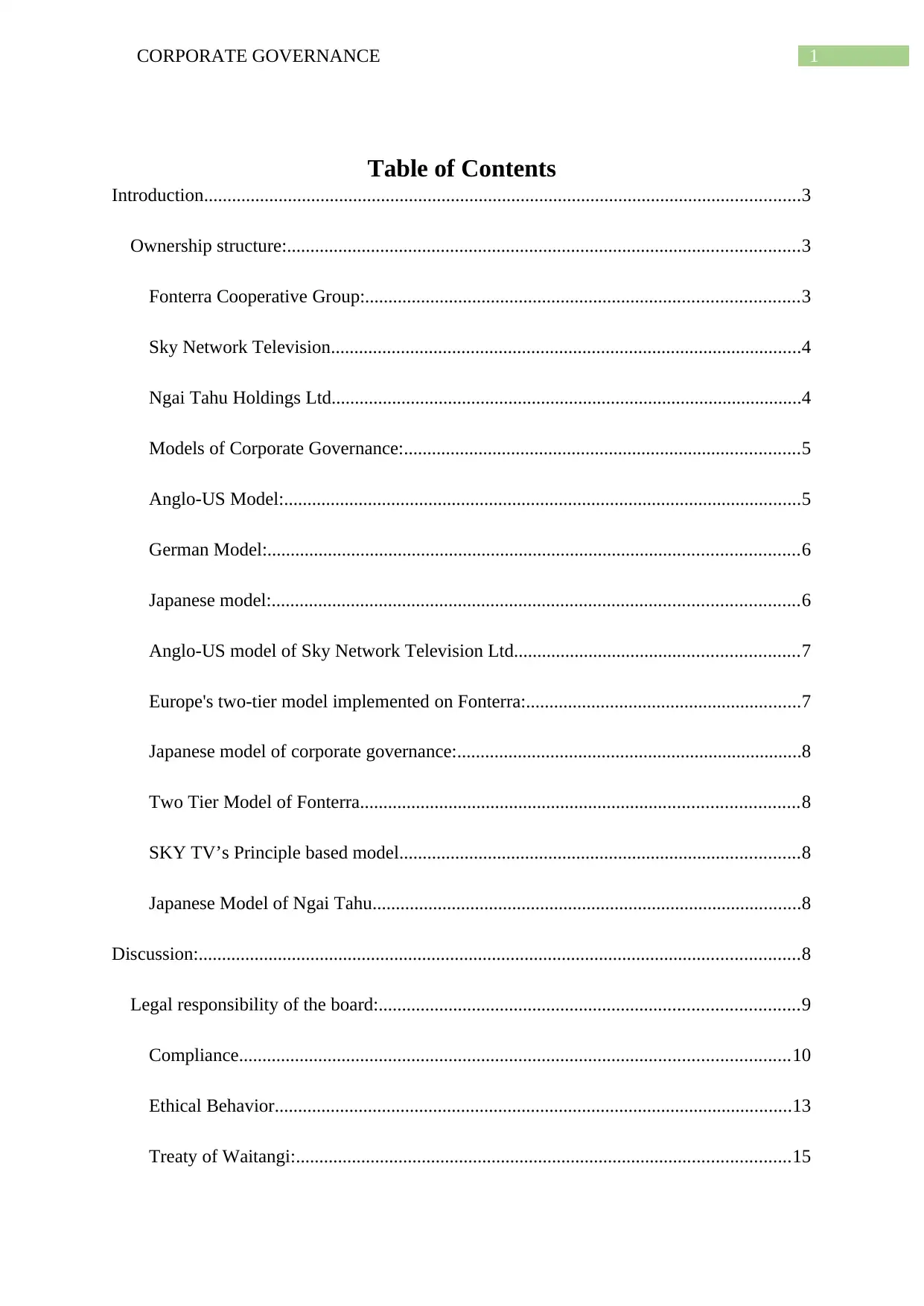
1CORPORATE GOVERNANCE
Table of Contents
Introduction................................................................................................................................3
Ownership structure:..............................................................................................................3
Fonterra Cooperative Group:.............................................................................................3
Sky Network Television.....................................................................................................4
Ngai Tahu Holdings Ltd.....................................................................................................4
Models of Corporate Governance:.....................................................................................5
Anglo-US Model:...............................................................................................................5
German Model:..................................................................................................................6
Japanese model:.................................................................................................................6
Anglo-US model of Sky Network Television Ltd.............................................................7
Europe's two-tier model implemented on Fonterra:...........................................................7
Japanese model of corporate governance:..........................................................................8
Two Tier Model of Fonterra..............................................................................................8
SKY TV’s Principle based model......................................................................................8
Japanese Model of Ngai Tahu............................................................................................8
Discussion:.................................................................................................................................8
Legal responsibility of the board:..........................................................................................9
Compliance......................................................................................................................10
Ethical Behavior...............................................................................................................13
Treaty of Waitangi:..........................................................................................................15
Table of Contents
Introduction................................................................................................................................3
Ownership structure:..............................................................................................................3
Fonterra Cooperative Group:.............................................................................................3
Sky Network Television.....................................................................................................4
Ngai Tahu Holdings Ltd.....................................................................................................4
Models of Corporate Governance:.....................................................................................5
Anglo-US Model:...............................................................................................................5
German Model:..................................................................................................................6
Japanese model:.................................................................................................................6
Anglo-US model of Sky Network Television Ltd.............................................................7
Europe's two-tier model implemented on Fonterra:...........................................................7
Japanese model of corporate governance:..........................................................................8
Two Tier Model of Fonterra..............................................................................................8
SKY TV’s Principle based model......................................................................................8
Japanese Model of Ngai Tahu............................................................................................8
Discussion:.................................................................................................................................8
Legal responsibility of the board:..........................................................................................9
Compliance......................................................................................................................10
Ethical Behavior...............................................................................................................13
Treaty of Waitangi:..........................................................................................................15
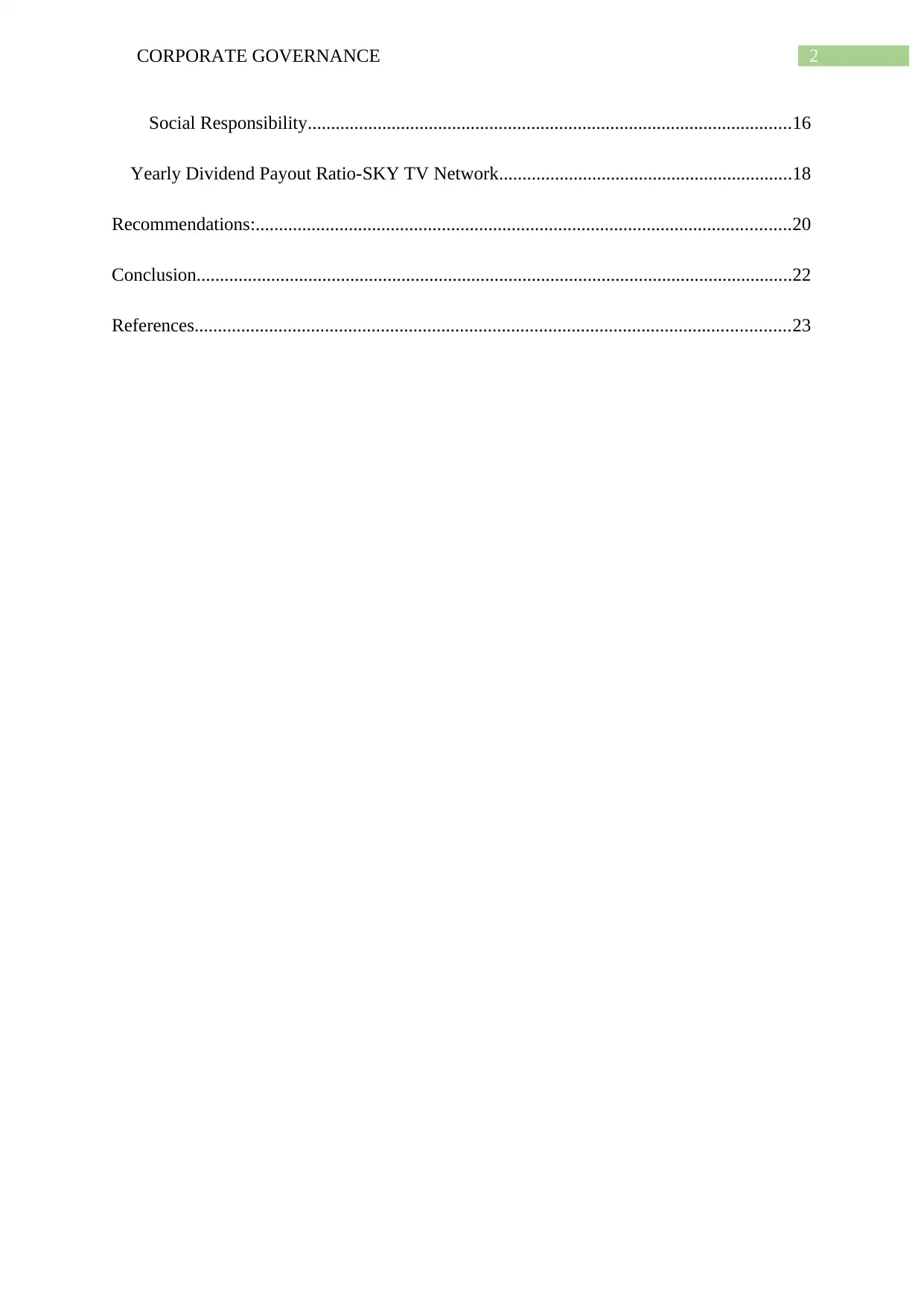
2CORPORATE GOVERNANCE
Social Responsibility........................................................................................................16
Yearly Dividend Payout Ratio-SKY TV Network...............................................................18
Recommendations:...................................................................................................................20
Conclusion................................................................................................................................22
References................................................................................................................................23
Social Responsibility........................................................................................................16
Yearly Dividend Payout Ratio-SKY TV Network...............................................................18
Recommendations:...................................................................................................................20
Conclusion................................................................................................................................22
References................................................................................................................................23
⊘ This is a preview!⊘
Do you want full access?
Subscribe today to unlock all pages.

Trusted by 1+ million students worldwide
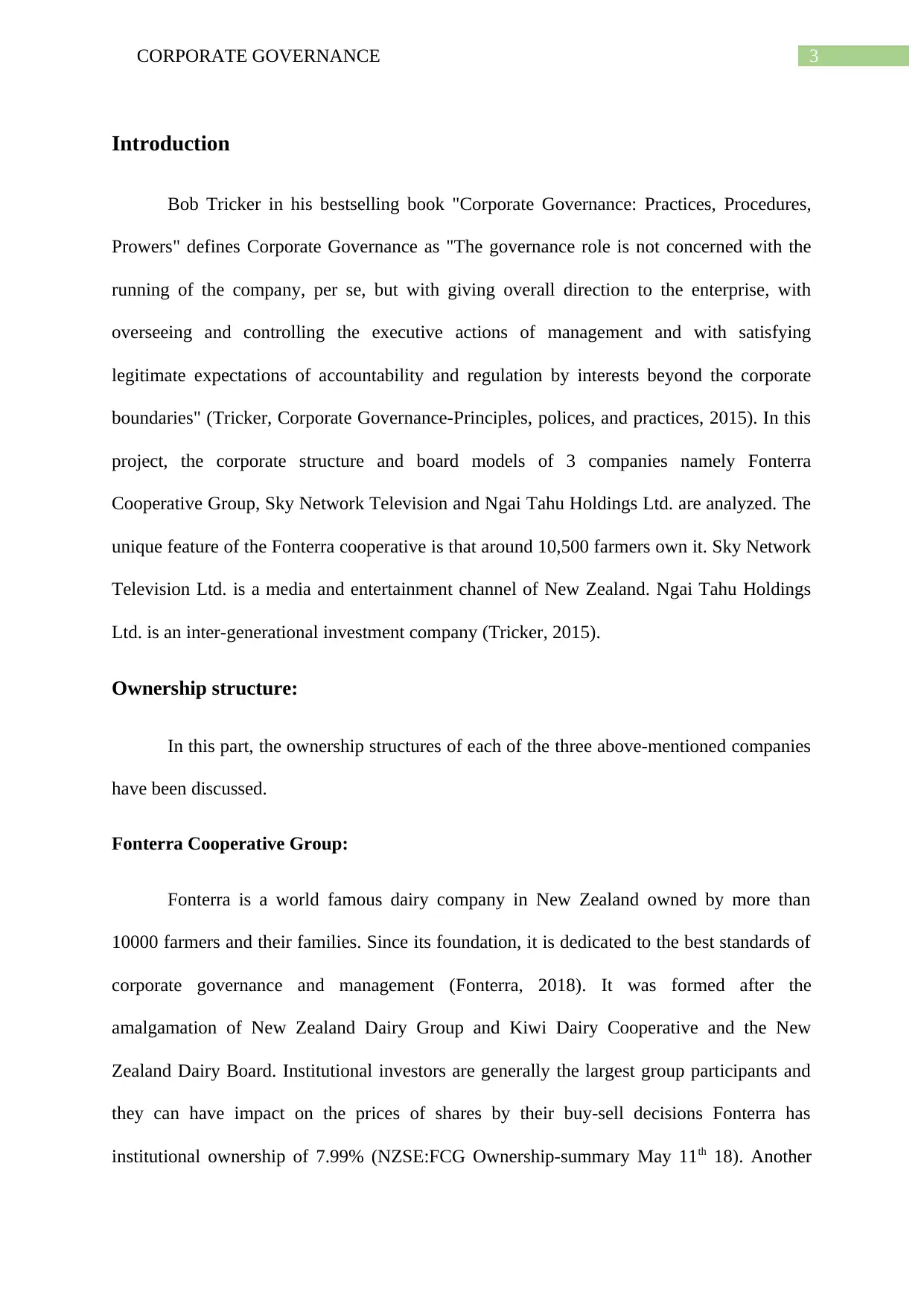
3CORPORATE GOVERNANCE
Introduction
Bob Tricker in his bestselling book "Corporate Governance: Practices, Procedures,
Prowers" defines Corporate Governance as "The governance role is not concerned with the
running of the company, per se, but with giving overall direction to the enterprise, with
overseeing and controlling the executive actions of management and with satisfying
legitimate expectations of accountability and regulation by interests beyond the corporate
boundaries" (Tricker, Corporate Governance-Principles, polices, and practices, 2015). In this
project, the corporate structure and board models of 3 companies namely Fonterra
Cooperative Group, Sky Network Television and Ngai Tahu Holdings Ltd. are analyzed. The
unique feature of the Fonterra cooperative is that around 10,500 farmers own it. Sky Network
Television Ltd. is a media and entertainment channel of New Zealand. Ngai Tahu Holdings
Ltd. is an inter-generational investment company (Tricker, 2015).
Ownership structure:
In this part, the ownership structures of each of the three above-mentioned companies
have been discussed.
Fonterra Cooperative Group:
Fonterra is a world famous dairy company in New Zealand owned by more than
10000 farmers and their families. Since its foundation, it is dedicated to the best standards of
corporate governance and management (Fonterra, 2018). It was formed after the
amalgamation of New Zealand Dairy Group and Kiwi Dairy Cooperative and the New
Zealand Dairy Board. Institutional investors are generally the largest group participants and
they can have impact on the prices of shares by their buy-sell decisions Fonterra has
institutional ownership of 7.99% (NZSE:FCG Ownership-summary May 11th 18). Another
Introduction
Bob Tricker in his bestselling book "Corporate Governance: Practices, Procedures,
Prowers" defines Corporate Governance as "The governance role is not concerned with the
running of the company, per se, but with giving overall direction to the enterprise, with
overseeing and controlling the executive actions of management and with satisfying
legitimate expectations of accountability and regulation by interests beyond the corporate
boundaries" (Tricker, Corporate Governance-Principles, polices, and practices, 2015). In this
project, the corporate structure and board models of 3 companies namely Fonterra
Cooperative Group, Sky Network Television and Ngai Tahu Holdings Ltd. are analyzed. The
unique feature of the Fonterra cooperative is that around 10,500 farmers own it. Sky Network
Television Ltd. is a media and entertainment channel of New Zealand. Ngai Tahu Holdings
Ltd. is an inter-generational investment company (Tricker, 2015).
Ownership structure:
In this part, the ownership structures of each of the three above-mentioned companies
have been discussed.
Fonterra Cooperative Group:
Fonterra is a world famous dairy company in New Zealand owned by more than
10000 farmers and their families. Since its foundation, it is dedicated to the best standards of
corporate governance and management (Fonterra, 2018). It was formed after the
amalgamation of New Zealand Dairy Group and Kiwi Dairy Cooperative and the New
Zealand Dairy Board. Institutional investors are generally the largest group participants and
they can have impact on the prices of shares by their buy-sell decisions Fonterra has
institutional ownership of 7.99% (NZSE:FCG Ownership-summary May 11th 18). Another
Paraphrase This Document
Need a fresh take? Get an instant paraphrase of this document with our AI Paraphraser
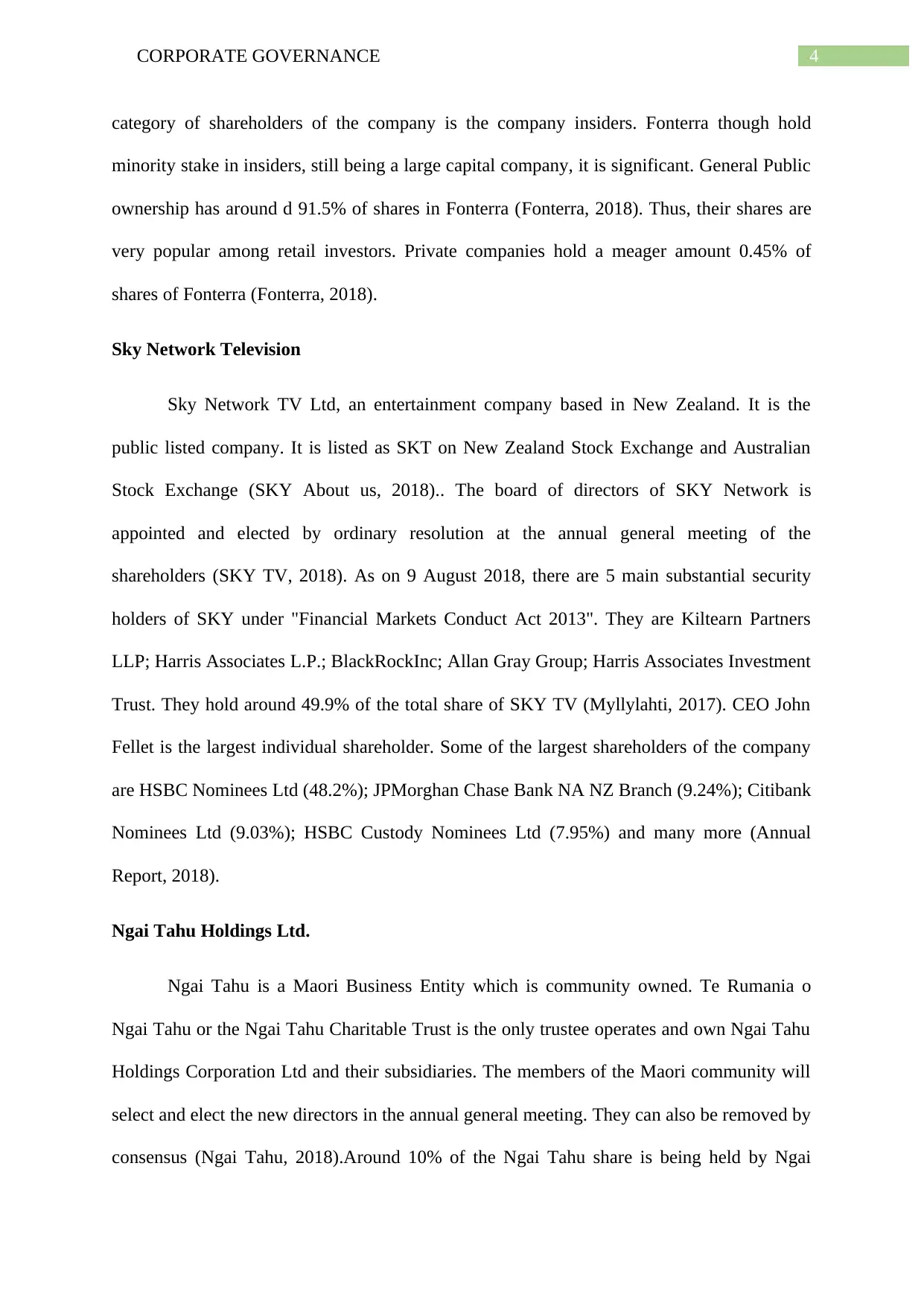
4CORPORATE GOVERNANCE
category of shareholders of the company is the company insiders. Fonterra though hold
minority stake in insiders, still being a large capital company, it is significant. General Public
ownership has around d 91.5% of shares in Fonterra (Fonterra, 2018). Thus, their shares are
very popular among retail investors. Private companies hold a meager amount 0.45% of
shares of Fonterra (Fonterra, 2018).
Sky Network Television
Sky Network TV Ltd, an entertainment company based in New Zealand. It is the
public listed company. It is listed as SKT on New Zealand Stock Exchange and Australian
Stock Exchange (SKY About us, 2018).. The board of directors of SKY Network is
appointed and elected by ordinary resolution at the annual general meeting of the
shareholders (SKY TV, 2018). As on 9 August 2018, there are 5 main substantial security
holders of SKY under "Financial Markets Conduct Act 2013". They are Kiltearn Partners
LLP; Harris Associates L.P.; BlackRockInc; Allan Gray Group; Harris Associates Investment
Trust. They hold around 49.9% of the total share of SKY TV (Myllylahti, 2017). CEO John
Fellet is the largest individual shareholder. Some of the largest shareholders of the company
are HSBC Nominees Ltd (48.2%); JPMorghan Chase Bank NA NZ Branch (9.24%); Citibank
Nominees Ltd (9.03%); HSBC Custody Nominees Ltd (7.95%) and many more (Annual
Report, 2018).
Ngai Tahu Holdings Ltd.
Ngai Tahu is a Maori Business Entity which is community owned. Te Rumania o
Ngai Tahu or the Ngai Tahu Charitable Trust is the only trustee operates and own Ngai Tahu
Holdings Corporation Ltd and their subsidiaries. The members of the Maori community will
select and elect the new directors in the annual general meeting. They can also be removed by
consensus (Ngai Tahu, 2018).Around 10% of the Ngai Tahu share is being held by Ngai
category of shareholders of the company is the company insiders. Fonterra though hold
minority stake in insiders, still being a large capital company, it is significant. General Public
ownership has around d 91.5% of shares in Fonterra (Fonterra, 2018). Thus, their shares are
very popular among retail investors. Private companies hold a meager amount 0.45% of
shares of Fonterra (Fonterra, 2018).
Sky Network Television
Sky Network TV Ltd, an entertainment company based in New Zealand. It is the
public listed company. It is listed as SKT on New Zealand Stock Exchange and Australian
Stock Exchange (SKY About us, 2018).. The board of directors of SKY Network is
appointed and elected by ordinary resolution at the annual general meeting of the
shareholders (SKY TV, 2018). As on 9 August 2018, there are 5 main substantial security
holders of SKY under "Financial Markets Conduct Act 2013". They are Kiltearn Partners
LLP; Harris Associates L.P.; BlackRockInc; Allan Gray Group; Harris Associates Investment
Trust. They hold around 49.9% of the total share of SKY TV (Myllylahti, 2017). CEO John
Fellet is the largest individual shareholder. Some of the largest shareholders of the company
are HSBC Nominees Ltd (48.2%); JPMorghan Chase Bank NA NZ Branch (9.24%); Citibank
Nominees Ltd (9.03%); HSBC Custody Nominees Ltd (7.95%) and many more (Annual
Report, 2018).
Ngai Tahu Holdings Ltd.
Ngai Tahu is a Maori Business Entity which is community owned. Te Rumania o
Ngai Tahu or the Ngai Tahu Charitable Trust is the only trustee operates and own Ngai Tahu
Holdings Corporation Ltd and their subsidiaries. The members of the Maori community will
select and elect the new directors in the annual general meeting. They can also be removed by
consensus (Ngai Tahu, 2018).Around 10% of the Ngai Tahu share is being held by Ngai
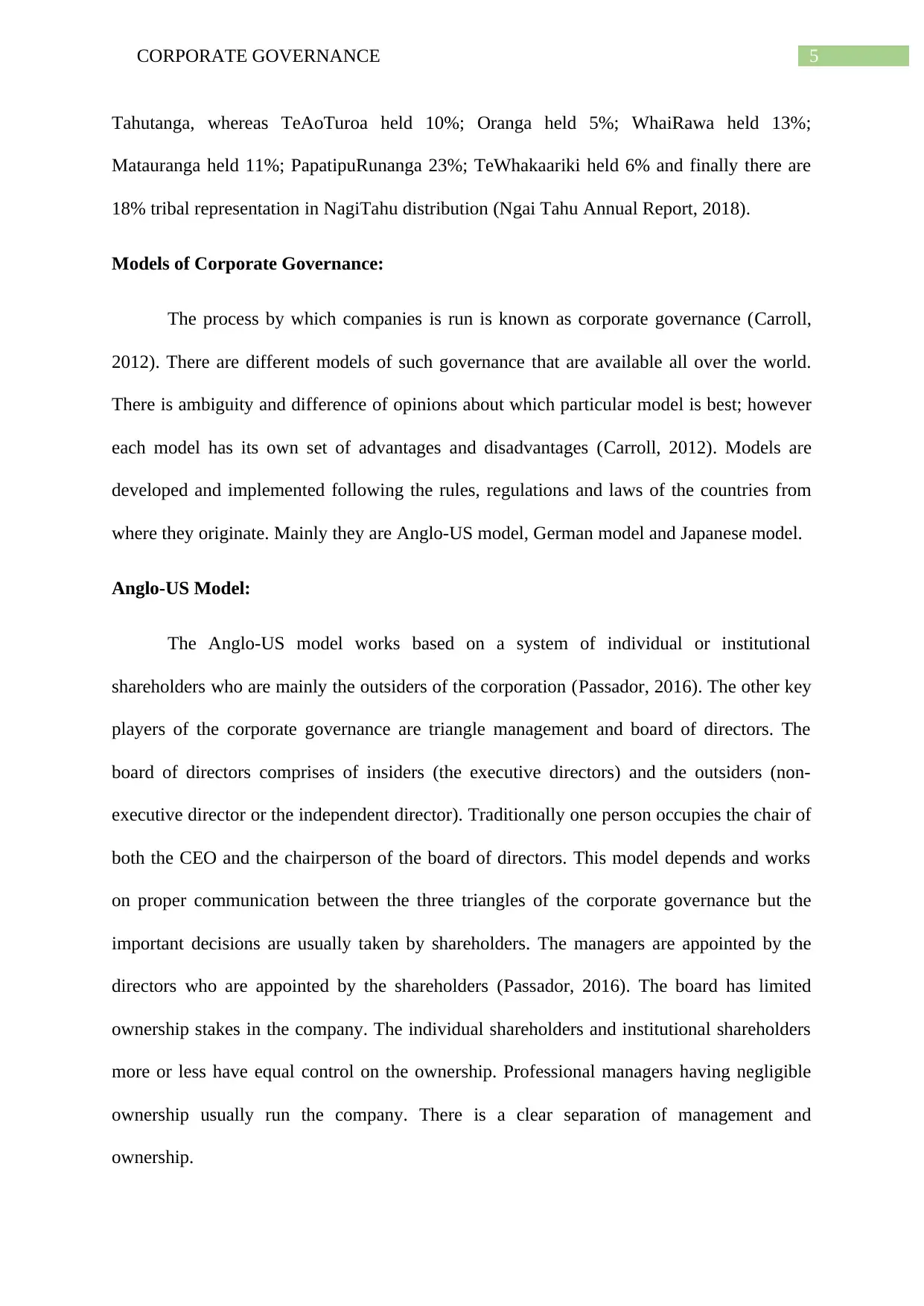
5CORPORATE GOVERNANCE
Tahutanga, whereas TeAoTuroa held 10%; Oranga held 5%; WhaiRawa held 13%;
Matauranga held 11%; PapatipuRunanga 23%; TeWhakaariki held 6% and finally there are
18% tribal representation in NagiTahu distribution (Ngai Tahu Annual Report, 2018).
Models of Corporate Governance:
The process by which companies is run is known as corporate governance (Carroll,
2012). There are different models of such governance that are available all over the world.
There is ambiguity and difference of opinions about which particular model is best; however
each model has its own set of advantages and disadvantages (Carroll, 2012). Models are
developed and implemented following the rules, regulations and laws of the countries from
where they originate. Mainly they are Anglo-US model, German model and Japanese model.
Anglo-US Model:
The Anglo-US model works based on a system of individual or institutional
shareholders who are mainly the outsiders of the corporation (Passador, 2016). The other key
players of the corporate governance are triangle management and board of directors. The
board of directors comprises of insiders (the executive directors) and the outsiders (non-
executive director or the independent director). Traditionally one person occupies the chair of
both the CEO and the chairperson of the board of directors. This model depends and works
on proper communication between the three triangles of the corporate governance but the
important decisions are usually taken by shareholders. The managers are appointed by the
directors who are appointed by the shareholders (Passador, 2016). The board has limited
ownership stakes in the company. The individual shareholders and institutional shareholders
more or less have equal control on the ownership. Professional managers having negligible
ownership usually run the company. There is a clear separation of management and
ownership.
Tahutanga, whereas TeAoTuroa held 10%; Oranga held 5%; WhaiRawa held 13%;
Matauranga held 11%; PapatipuRunanga 23%; TeWhakaariki held 6% and finally there are
18% tribal representation in NagiTahu distribution (Ngai Tahu Annual Report, 2018).
Models of Corporate Governance:
The process by which companies is run is known as corporate governance (Carroll,
2012). There are different models of such governance that are available all over the world.
There is ambiguity and difference of opinions about which particular model is best; however
each model has its own set of advantages and disadvantages (Carroll, 2012). Models are
developed and implemented following the rules, regulations and laws of the countries from
where they originate. Mainly they are Anglo-US model, German model and Japanese model.
Anglo-US Model:
The Anglo-US model works based on a system of individual or institutional
shareholders who are mainly the outsiders of the corporation (Passador, 2016). The other key
players of the corporate governance are triangle management and board of directors. The
board of directors comprises of insiders (the executive directors) and the outsiders (non-
executive director or the independent director). Traditionally one person occupies the chair of
both the CEO and the chairperson of the board of directors. This model depends and works
on proper communication between the three triangles of the corporate governance but the
important decisions are usually taken by shareholders. The managers are appointed by the
directors who are appointed by the shareholders (Passador, 2016). The board has limited
ownership stakes in the company. The individual shareholders and institutional shareholders
more or less have equal control on the ownership. Professional managers having negligible
ownership usually run the company. There is a clear separation of management and
ownership.
⊘ This is a preview!⊘
Do you want full access?
Subscribe today to unlock all pages.

Trusted by 1+ million students worldwide
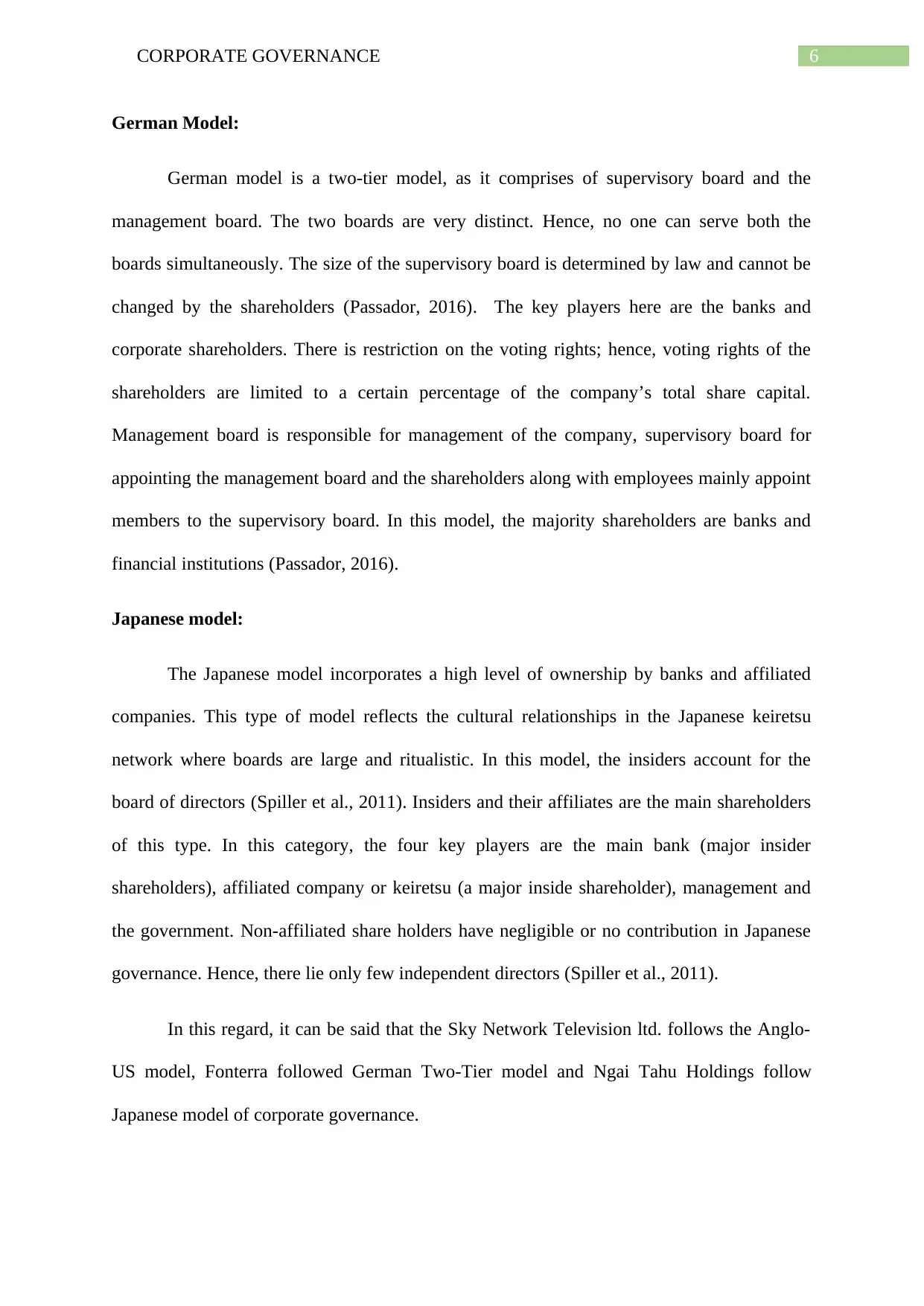
6CORPORATE GOVERNANCE
German Model:
German model is a two-tier model, as it comprises of supervisory board and the
management board. The two boards are very distinct. Hence, no one can serve both the
boards simultaneously. The size of the supervisory board is determined by law and cannot be
changed by the shareholders (Passador, 2016). The key players here are the banks and
corporate shareholders. There is restriction on the voting rights; hence, voting rights of the
shareholders are limited to a certain percentage of the company’s total share capital.
Management board is responsible for management of the company, supervisory board for
appointing the management board and the shareholders along with employees mainly appoint
members to the supervisory board. In this model, the majority shareholders are banks and
financial institutions (Passador, 2016).
Japanese model:
The Japanese model incorporates a high level of ownership by banks and affiliated
companies. This type of model reflects the cultural relationships in the Japanese keiretsu
network where boards are large and ritualistic. In this model, the insiders account for the
board of directors (Spiller et al., 2011). Insiders and their affiliates are the main shareholders
of this type. In this category, the four key players are the main bank (major insider
shareholders), affiliated company or keiretsu (a major inside shareholder), management and
the government. Non-affiliated share holders have negligible or no contribution in Japanese
governance. Hence, there lie only few independent directors (Spiller et al., 2011).
In this regard, it can be said that the Sky Network Television ltd. follows the Anglo-
US model, Fonterra followed German Two-Tier model and Ngai Tahu Holdings follow
Japanese model of corporate governance.
German Model:
German model is a two-tier model, as it comprises of supervisory board and the
management board. The two boards are very distinct. Hence, no one can serve both the
boards simultaneously. The size of the supervisory board is determined by law and cannot be
changed by the shareholders (Passador, 2016). The key players here are the banks and
corporate shareholders. There is restriction on the voting rights; hence, voting rights of the
shareholders are limited to a certain percentage of the company’s total share capital.
Management board is responsible for management of the company, supervisory board for
appointing the management board and the shareholders along with employees mainly appoint
members to the supervisory board. In this model, the majority shareholders are banks and
financial institutions (Passador, 2016).
Japanese model:
The Japanese model incorporates a high level of ownership by banks and affiliated
companies. This type of model reflects the cultural relationships in the Japanese keiretsu
network where boards are large and ritualistic. In this model, the insiders account for the
board of directors (Spiller et al., 2011). Insiders and their affiliates are the main shareholders
of this type. In this category, the four key players are the main bank (major insider
shareholders), affiliated company or keiretsu (a major inside shareholder), management and
the government. Non-affiliated share holders have negligible or no contribution in Japanese
governance. Hence, there lie only few independent directors (Spiller et al., 2011).
In this regard, it can be said that the Sky Network Television ltd. follows the Anglo-
US model, Fonterra followed German Two-Tier model and Ngai Tahu Holdings follow
Japanese model of corporate governance.
Paraphrase This Document
Need a fresh take? Get an instant paraphrase of this document with our AI Paraphraser
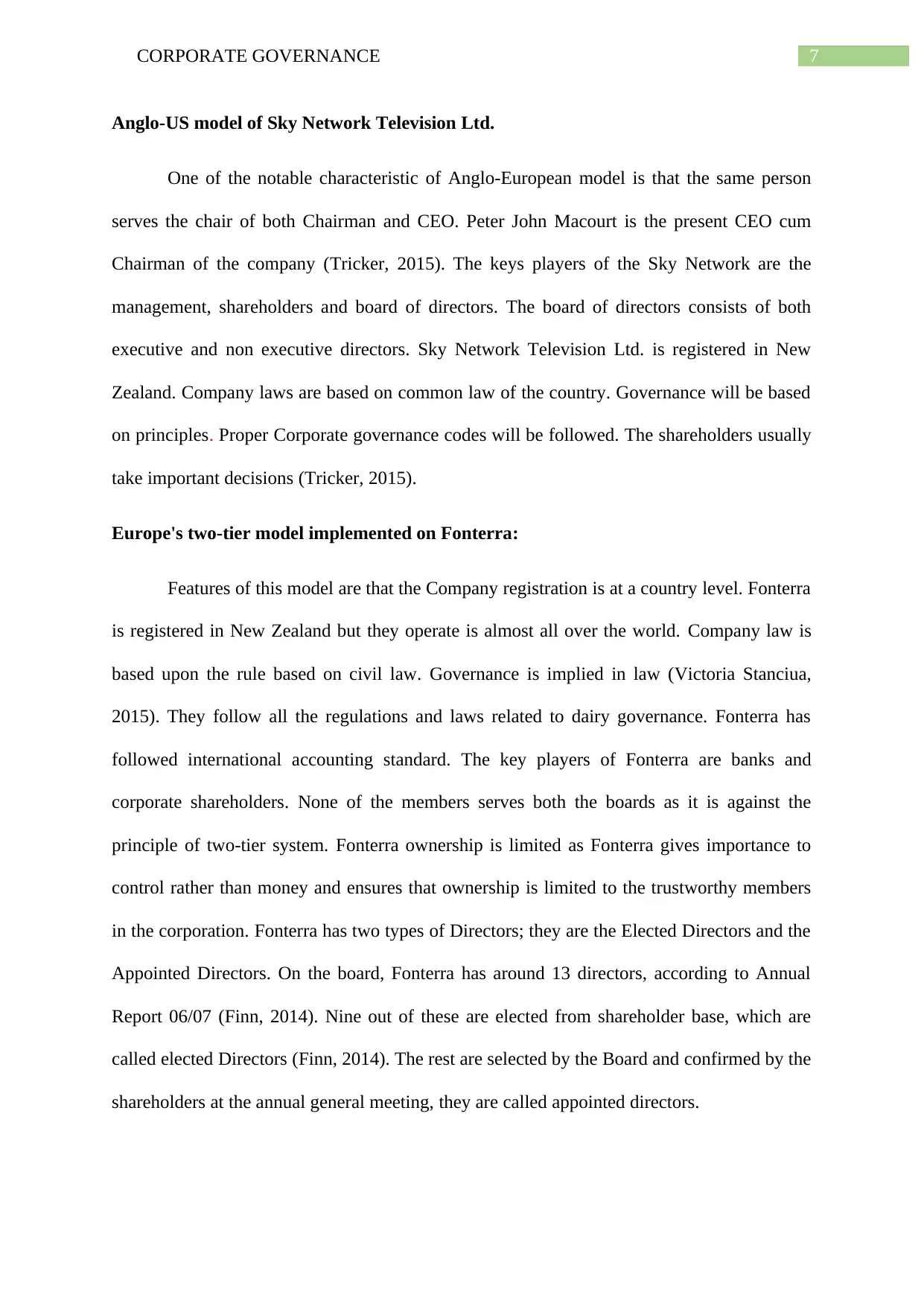
7CORPORATE GOVERNANCE
Anglo-US model of Sky Network Television Ltd.
One of the notable characteristic of Anglo-European model is that the same person
serves the chair of both Chairman and CEO. Peter John Macourt is the present CEO cum
Chairman of the company (Tricker, 2015). The keys players of the Sky Network are the
management, shareholders and board of directors. The board of directors consists of both
executive and non executive directors. Sky Network Television Ltd. is registered in New
Zealand. Company laws are based on common law of the country. Governance will be based
on principles. Proper Corporate governance codes will be followed. The shareholders usually
take important decisions (Tricker, 2015).
Europe's two-tier model implemented on Fonterra:
Features of this model are that the Company registration is at a country level. Fonterra
is registered in New Zealand but they operate is almost all over the world. Company law is
based upon the rule based on civil law. Governance is implied in law (Victoria Stanciua,
2015). They follow all the regulations and laws related to dairy governance. Fonterra has
followed international accounting standard. The key players of Fonterra are banks and
corporate shareholders. None of the members serves both the boards as it is against the
principle of two-tier system. Fonterra ownership is limited as Fonterra gives importance to
control rather than money and ensures that ownership is limited to the trustworthy members
in the corporation. Fonterra has two types of Directors; they are the Elected Directors and the
Appointed Directors. On the board, Fonterra has around 13 directors, according to Annual
Report 06/07 (Finn, 2014). Nine out of these are elected from shareholder base, which are
called elected Directors (Finn, 2014). The rest are selected by the Board and confirmed by the
shareholders at the annual general meeting, they are called appointed directors.
Anglo-US model of Sky Network Television Ltd.
One of the notable characteristic of Anglo-European model is that the same person
serves the chair of both Chairman and CEO. Peter John Macourt is the present CEO cum
Chairman of the company (Tricker, 2015). The keys players of the Sky Network are the
management, shareholders and board of directors. The board of directors consists of both
executive and non executive directors. Sky Network Television Ltd. is registered in New
Zealand. Company laws are based on common law of the country. Governance will be based
on principles. Proper Corporate governance codes will be followed. The shareholders usually
take important decisions (Tricker, 2015).
Europe's two-tier model implemented on Fonterra:
Features of this model are that the Company registration is at a country level. Fonterra
is registered in New Zealand but they operate is almost all over the world. Company law is
based upon the rule based on civil law. Governance is implied in law (Victoria Stanciua,
2015). They follow all the regulations and laws related to dairy governance. Fonterra has
followed international accounting standard. The key players of Fonterra are banks and
corporate shareholders. None of the members serves both the boards as it is against the
principle of two-tier system. Fonterra ownership is limited as Fonterra gives importance to
control rather than money and ensures that ownership is limited to the trustworthy members
in the corporation. Fonterra has two types of Directors; they are the Elected Directors and the
Appointed Directors. On the board, Fonterra has around 13 directors, according to Annual
Report 06/07 (Finn, 2014). Nine out of these are elected from shareholder base, which are
called elected Directors (Finn, 2014). The rest are selected by the Board and confirmed by the
shareholders at the annual general meeting, they are called appointed directors.
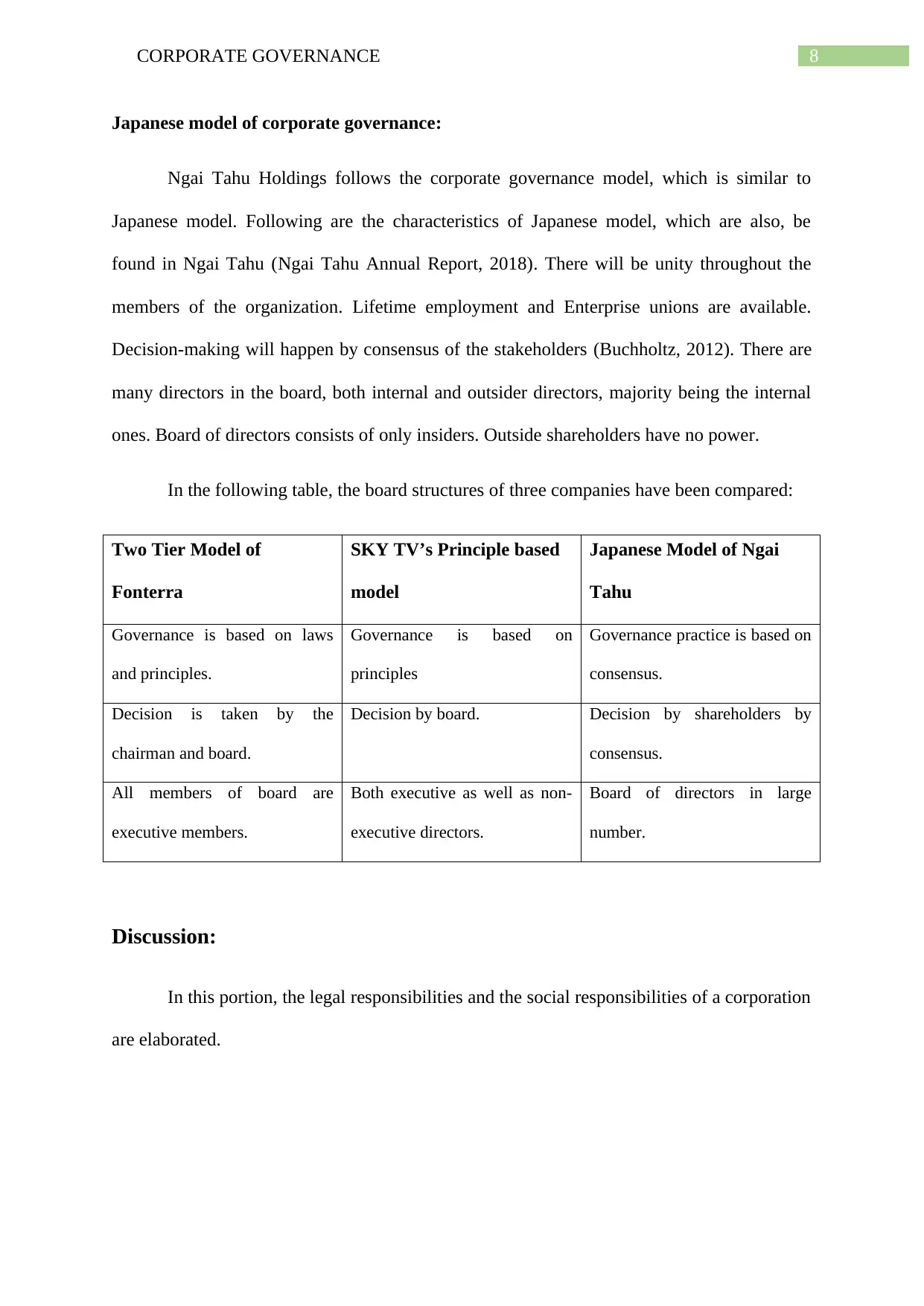
8CORPORATE GOVERNANCE
Japanese model of corporate governance:
Ngai Tahu Holdings follows the corporate governance model, which is similar to
Japanese model. Following are the characteristics of Japanese model, which are also, be
found in Ngai Tahu (Ngai Tahu Annual Report, 2018). There will be unity throughout the
members of the organization. Lifetime employment and Enterprise unions are available.
Decision-making will happen by consensus of the stakeholders (Buchholtz, 2012). There are
many directors in the board, both internal and outsider directors, majority being the internal
ones. Board of directors consists of only insiders. Outside shareholders have no power.
In the following table, the board structures of three companies have been compared:
Two Tier Model of
Fonterra
SKY TV’s Principle based
model
Japanese Model of Ngai
Tahu
Governance is based on laws
and principles.
Governance is based on
principles
Governance practice is based on
consensus.
Decision is taken by the
chairman and board.
Decision by board. Decision by shareholders by
consensus.
All members of board are
executive members.
Both executive as well as non-
executive directors.
Board of directors in large
number.
Discussion:
In this portion, the legal responsibilities and the social responsibilities of a corporation
are elaborated.
Japanese model of corporate governance:
Ngai Tahu Holdings follows the corporate governance model, which is similar to
Japanese model. Following are the characteristics of Japanese model, which are also, be
found in Ngai Tahu (Ngai Tahu Annual Report, 2018). There will be unity throughout the
members of the organization. Lifetime employment and Enterprise unions are available.
Decision-making will happen by consensus of the stakeholders (Buchholtz, 2012). There are
many directors in the board, both internal and outsider directors, majority being the internal
ones. Board of directors consists of only insiders. Outside shareholders have no power.
In the following table, the board structures of three companies have been compared:
Two Tier Model of
Fonterra
SKY TV’s Principle based
model
Japanese Model of Ngai
Tahu
Governance is based on laws
and principles.
Governance is based on
principles
Governance practice is based on
consensus.
Decision is taken by the
chairman and board.
Decision by board. Decision by shareholders by
consensus.
All members of board are
executive members.
Both executive as well as non-
executive directors.
Board of directors in large
number.
Discussion:
In this portion, the legal responsibilities and the social responsibilities of a corporation
are elaborated.
⊘ This is a preview!⊘
Do you want full access?
Subscribe today to unlock all pages.

Trusted by 1+ million students worldwide
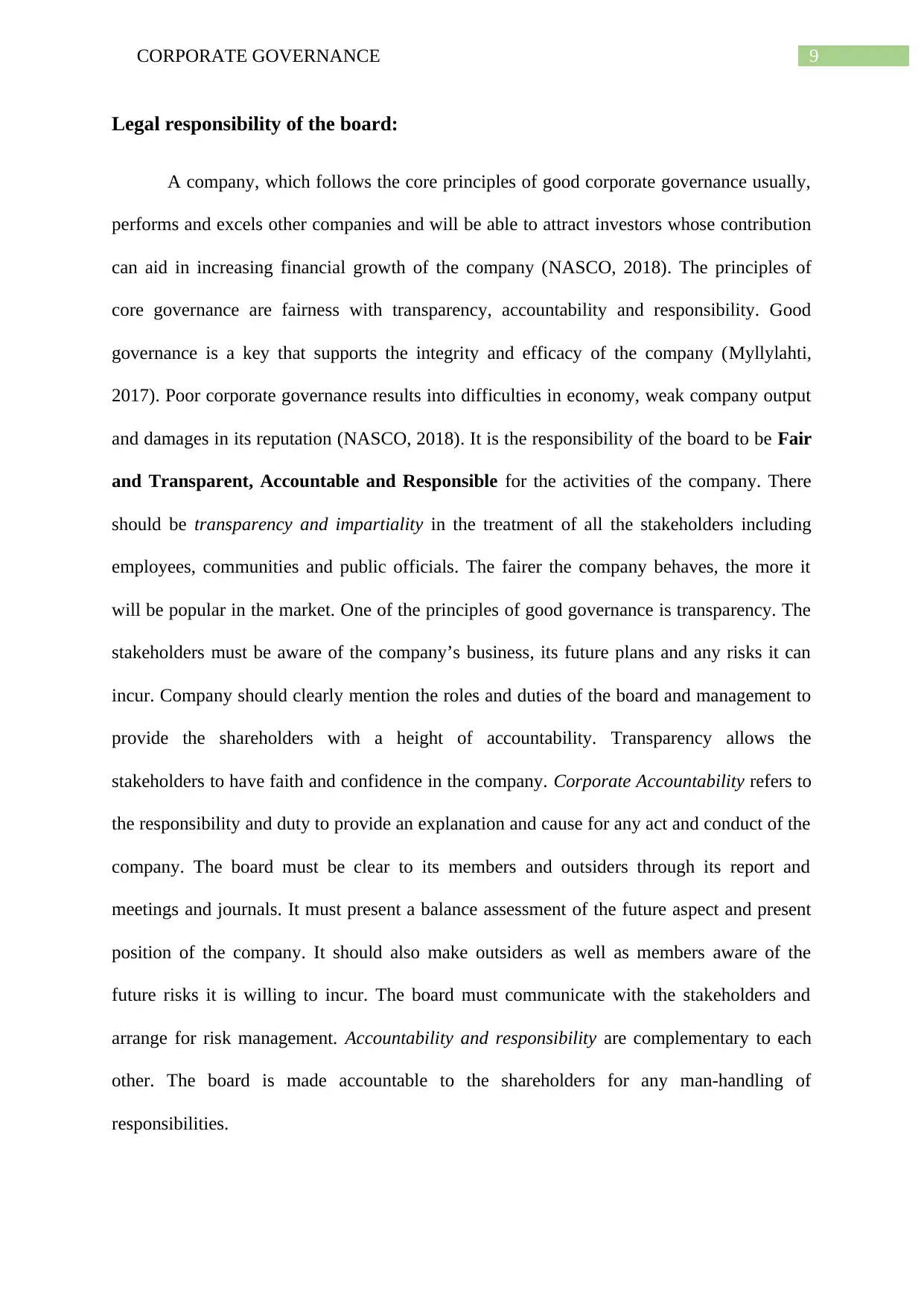
9CORPORATE GOVERNANCE
Legal responsibility of the board:
A company, which follows the core principles of good corporate governance usually,
performs and excels other companies and will be able to attract investors whose contribution
can aid in increasing financial growth of the company (NASCO, 2018). The principles of
core governance are fairness with transparency, accountability and responsibility. Good
governance is a key that supports the integrity and efficacy of the company (Myllylahti,
2017). Poor corporate governance results into difficulties in economy, weak company output
and damages in its reputation (NASCO, 2018). It is the responsibility of the board to be Fair
and Transparent, Accountable and Responsible for the activities of the company. There
should be transparency and impartiality in the treatment of all the stakeholders including
employees, communities and public officials. The fairer the company behaves, the more it
will be popular in the market. One of the principles of good governance is transparency. The
stakeholders must be aware of the company’s business, its future plans and any risks it can
incur. Company should clearly mention the roles and duties of the board and management to
provide the shareholders with a height of accountability. Transparency allows the
stakeholders to have faith and confidence in the company. Corporate Accountability refers to
the responsibility and duty to provide an explanation and cause for any act and conduct of the
company. The board must be clear to its members and outsiders through its report and
meetings and journals. It must present a balance assessment of the future aspect and present
position of the company. It should also make outsiders as well as members aware of the
future risks it is willing to incur. The board must communicate with the stakeholders and
arrange for risk management. Accountability and responsibility are complementary to each
other. The board is made accountable to the shareholders for any man-handling of
responsibilities.
Legal responsibility of the board:
A company, which follows the core principles of good corporate governance usually,
performs and excels other companies and will be able to attract investors whose contribution
can aid in increasing financial growth of the company (NASCO, 2018). The principles of
core governance are fairness with transparency, accountability and responsibility. Good
governance is a key that supports the integrity and efficacy of the company (Myllylahti,
2017). Poor corporate governance results into difficulties in economy, weak company output
and damages in its reputation (NASCO, 2018). It is the responsibility of the board to be Fair
and Transparent, Accountable and Responsible for the activities of the company. There
should be transparency and impartiality in the treatment of all the stakeholders including
employees, communities and public officials. The fairer the company behaves, the more it
will be popular in the market. One of the principles of good governance is transparency. The
stakeholders must be aware of the company’s business, its future plans and any risks it can
incur. Company should clearly mention the roles and duties of the board and management to
provide the shareholders with a height of accountability. Transparency allows the
stakeholders to have faith and confidence in the company. Corporate Accountability refers to
the responsibility and duty to provide an explanation and cause for any act and conduct of the
company. The board must be clear to its members and outsiders through its report and
meetings and journals. It must present a balance assessment of the future aspect and present
position of the company. It should also make outsiders as well as members aware of the
future risks it is willing to incur. The board must communicate with the stakeholders and
arrange for risk management. Accountability and responsibility are complementary to each
other. The board is made accountable to the shareholders for any man-handling of
responsibilities.
Paraphrase This Document
Need a fresh take? Get an instant paraphrase of this document with our AI Paraphraser
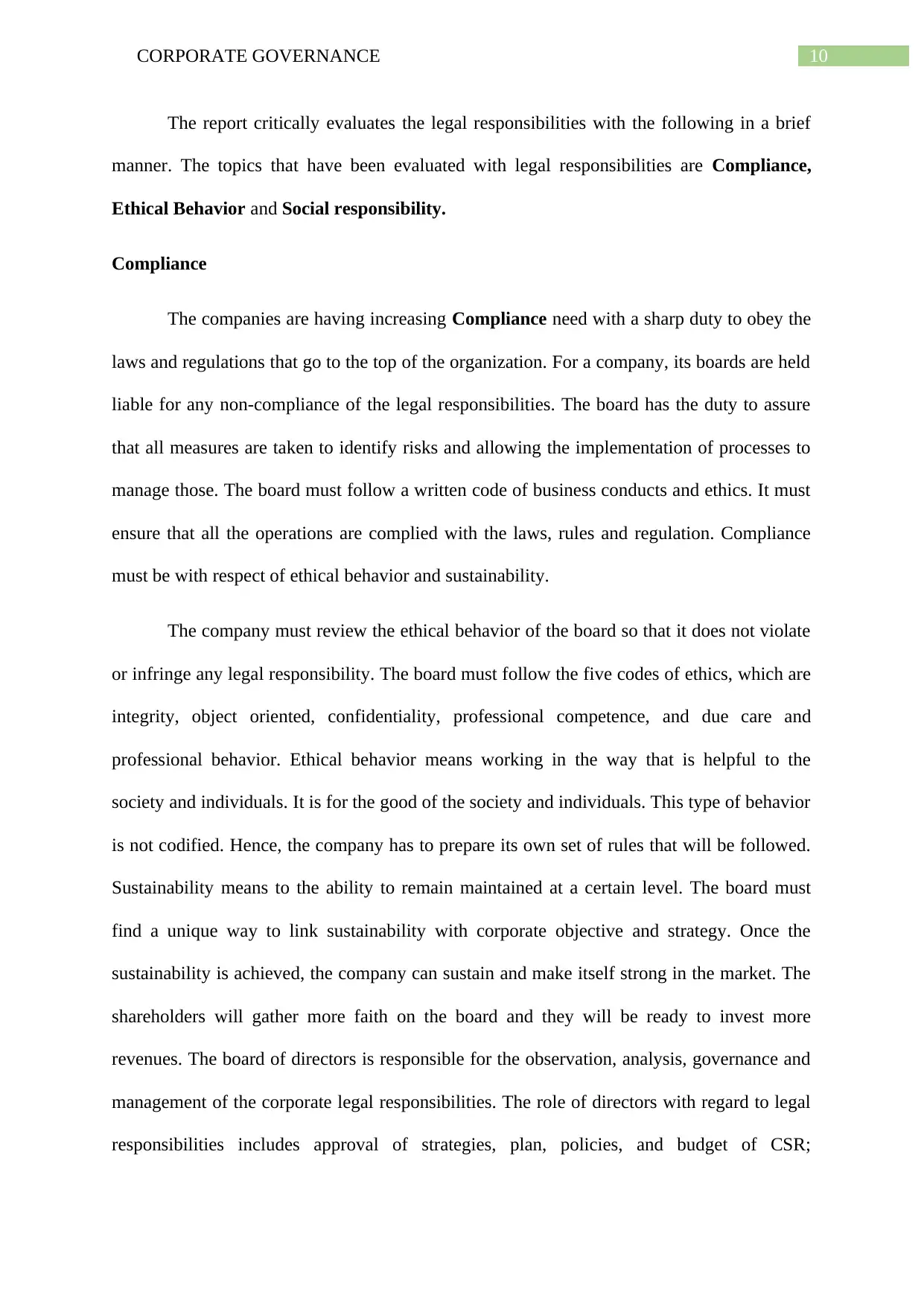
10CORPORATE GOVERNANCE
The report critically evaluates the legal responsibilities with the following in a brief
manner. The topics that have been evaluated with legal responsibilities are Compliance,
Ethical Behavior and Social responsibility.
Compliance
The companies are having increasing Compliance need with a sharp duty to obey the
laws and regulations that go to the top of the organization. For a company, its boards are held
liable for any non-compliance of the legal responsibilities. The board has the duty to assure
that all measures are taken to identify risks and allowing the implementation of processes to
manage those. The board must follow a written code of business conducts and ethics. It must
ensure that all the operations are complied with the laws, rules and regulation. Compliance
must be with respect of ethical behavior and sustainability.
The company must review the ethical behavior of the board so that it does not violate
or infringe any legal responsibility. The board must follow the five codes of ethics, which are
integrity, object oriented, confidentiality, professional competence, and due care and
professional behavior. Ethical behavior means working in the way that is helpful to the
society and individuals. It is for the good of the society and individuals. This type of behavior
is not codified. Hence, the company has to prepare its own set of rules that will be followed.
Sustainability means to the ability to remain maintained at a certain level. The board must
find a unique way to link sustainability with corporate objective and strategy. Once the
sustainability is achieved, the company can sustain and make itself strong in the market. The
shareholders will gather more faith on the board and they will be ready to invest more
revenues. The board of directors is responsible for the observation, analysis, governance and
management of the corporate legal responsibilities. The role of directors with regard to legal
responsibilities includes approval of strategies, plan, policies, and budget of CSR;
The report critically evaluates the legal responsibilities with the following in a brief
manner. The topics that have been evaluated with legal responsibilities are Compliance,
Ethical Behavior and Social responsibility.
Compliance
The companies are having increasing Compliance need with a sharp duty to obey the
laws and regulations that go to the top of the organization. For a company, its boards are held
liable for any non-compliance of the legal responsibilities. The board has the duty to assure
that all measures are taken to identify risks and allowing the implementation of processes to
manage those. The board must follow a written code of business conducts and ethics. It must
ensure that all the operations are complied with the laws, rules and regulation. Compliance
must be with respect of ethical behavior and sustainability.
The company must review the ethical behavior of the board so that it does not violate
or infringe any legal responsibility. The board must follow the five codes of ethics, which are
integrity, object oriented, confidentiality, professional competence, and due care and
professional behavior. Ethical behavior means working in the way that is helpful to the
society and individuals. It is for the good of the society and individuals. This type of behavior
is not codified. Hence, the company has to prepare its own set of rules that will be followed.
Sustainability means to the ability to remain maintained at a certain level. The board must
find a unique way to link sustainability with corporate objective and strategy. Once the
sustainability is achieved, the company can sustain and make itself strong in the market. The
shareholders will gather more faith on the board and they will be ready to invest more
revenues. The board of directors is responsible for the observation, analysis, governance and
management of the corporate legal responsibilities. The role of directors with regard to legal
responsibilities includes approval of strategies, plan, policies, and budget of CSR;
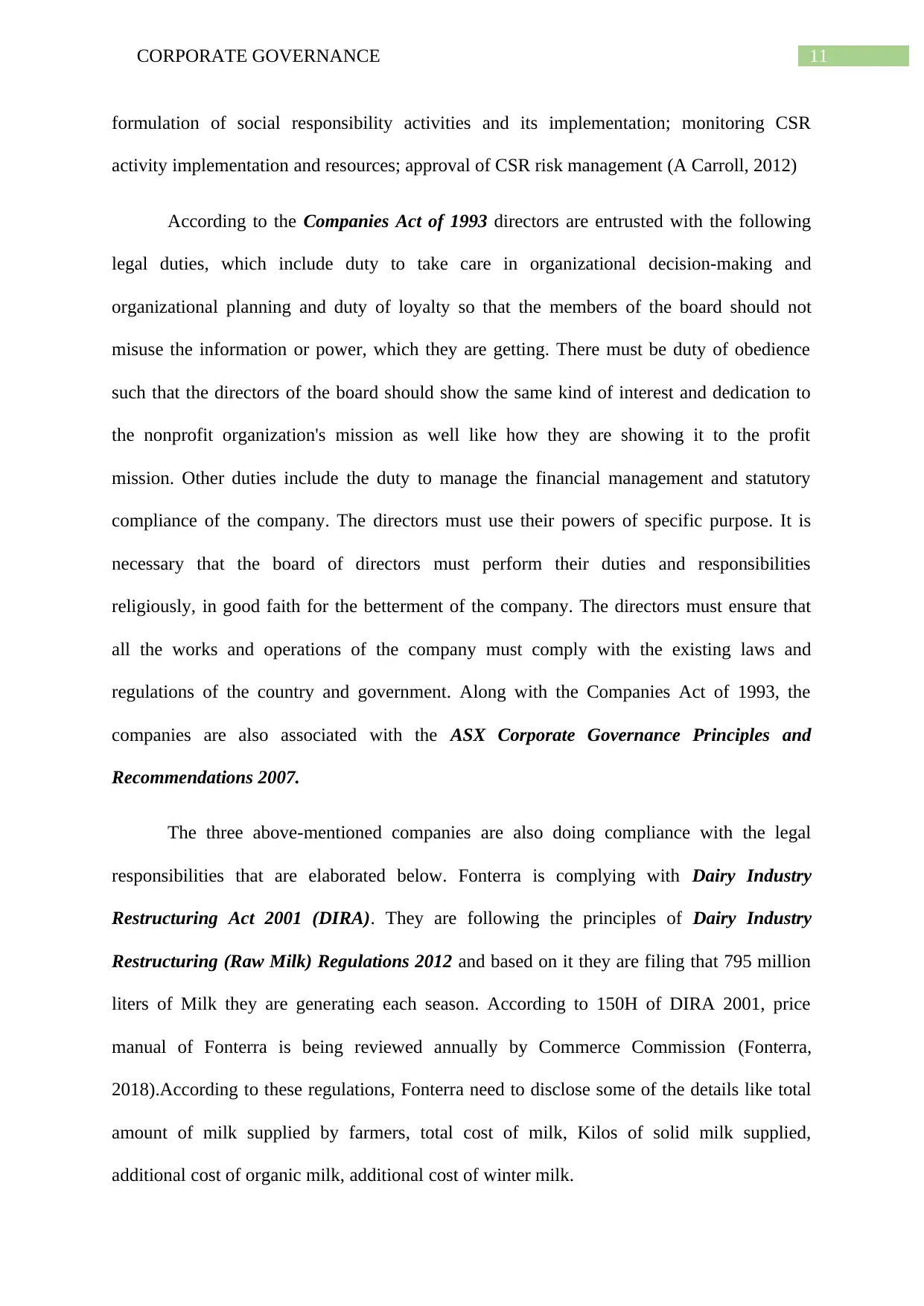
11CORPORATE GOVERNANCE
formulation of social responsibility activities and its implementation; monitoring CSR
activity implementation and resources; approval of CSR risk management (A Carroll, 2012)
According to the Companies Act of 1993 directors are entrusted with the following
legal duties, which include duty to take care in organizational decision-making and
organizational planning and duty of loyalty so that the members of the board should not
misuse the information or power, which they are getting. There must be duty of obedience
such that the directors of the board should show the same kind of interest and dedication to
the nonprofit organization's mission as well like how they are showing it to the profit
mission. Other duties include the duty to manage the financial management and statutory
compliance of the company. The directors must use their powers of specific purpose. It is
necessary that the board of directors must perform their duties and responsibilities
religiously, in good faith for the betterment of the company. The directors must ensure that
all the works and operations of the company must comply with the existing laws and
regulations of the country and government. Along with the Companies Act of 1993, the
companies are also associated with the ASX Corporate Governance Principles and
Recommendations 2007.
The three above-mentioned companies are also doing compliance with the legal
responsibilities that are elaborated below. Fonterra is complying with Dairy Industry
Restructuring Act 2001 (DIRA). They are following the principles of Dairy Industry
Restructuring (Raw Milk) Regulations 2012 and based on it they are filing that 795 million
liters of Milk they are generating each season. According to 150H of DIRA 2001, price
manual of Fonterra is being reviewed annually by Commerce Commission (Fonterra,
2018).According to these regulations, Fonterra need to disclose some of the details like total
amount of milk supplied by farmers, total cost of milk, Kilos of solid milk supplied,
additional cost of organic milk, additional cost of winter milk.
formulation of social responsibility activities and its implementation; monitoring CSR
activity implementation and resources; approval of CSR risk management (A Carroll, 2012)
According to the Companies Act of 1993 directors are entrusted with the following
legal duties, which include duty to take care in organizational decision-making and
organizational planning and duty of loyalty so that the members of the board should not
misuse the information or power, which they are getting. There must be duty of obedience
such that the directors of the board should show the same kind of interest and dedication to
the nonprofit organization's mission as well like how they are showing it to the profit
mission. Other duties include the duty to manage the financial management and statutory
compliance of the company. The directors must use their powers of specific purpose. It is
necessary that the board of directors must perform their duties and responsibilities
religiously, in good faith for the betterment of the company. The directors must ensure that
all the works and operations of the company must comply with the existing laws and
regulations of the country and government. Along with the Companies Act of 1993, the
companies are also associated with the ASX Corporate Governance Principles and
Recommendations 2007.
The three above-mentioned companies are also doing compliance with the legal
responsibilities that are elaborated below. Fonterra is complying with Dairy Industry
Restructuring Act 2001 (DIRA). They are following the principles of Dairy Industry
Restructuring (Raw Milk) Regulations 2012 and based on it they are filing that 795 million
liters of Milk they are generating each season. According to 150H of DIRA 2001, price
manual of Fonterra is being reviewed annually by Commerce Commission (Fonterra,
2018).According to these regulations, Fonterra need to disclose some of the details like total
amount of milk supplied by farmers, total cost of milk, Kilos of solid milk supplied,
additional cost of organic milk, additional cost of winter milk.
⊘ This is a preview!⊘
Do you want full access?
Subscribe today to unlock all pages.

Trusted by 1+ million students worldwide
1 out of 31
Your All-in-One AI-Powered Toolkit for Academic Success.
+13062052269
info@desklib.com
Available 24*7 on WhatsApp / Email
![[object Object]](/_next/static/media/star-bottom.7253800d.svg)
Unlock your academic potential
Copyright © 2020–2025 A2Z Services. All Rights Reserved. Developed and managed by ZUCOL.


